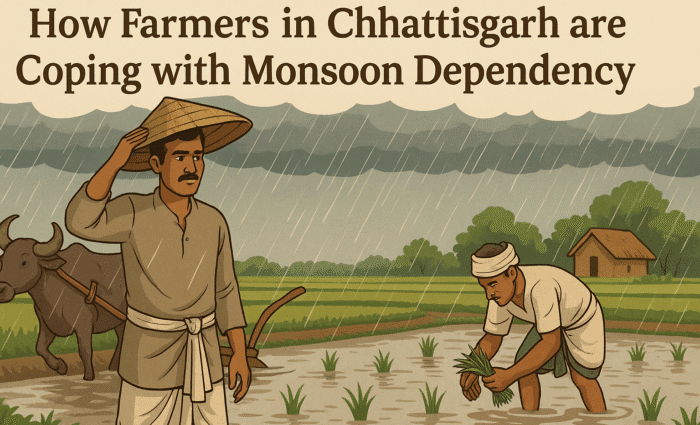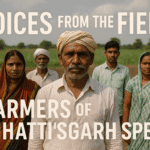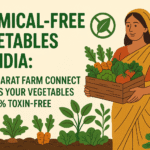Introduction
For generations, farmers in Chhattisgarh have depended heavily on the monsoon to cultivate paddy, vegetables, and other seasonal crops. Known as the “Rice Bowl of India,” the state’s agricultural success is tied closely to rainfall. However, with climate change, unpredictable monsoon patterns, and delayed rains, this dependency has created serious challenges for farmers. From reduced yields to financial instability, the risks are growing.
Yet, amidst these struggles, farmers are finding new ways to adapt—through irrigation improvements, crop diversification, sustainable practices, and digital marketplaces like Bharat Farm Connect that help them secure fair prices regardless of seasonal uncertainties.
Why Monsoon Dependency is a Major Challenge in Chhattisgarh
Unpredictable Rainfall: Farmers often face delayed or uneven rains that disrupt sowing schedules.
Single-Crop Dominance (Paddy): Heavy reliance on paddy means if the monsoon fails, most farmers face total losses.
Low Irrigation Coverage: Despite having rivers, groundwater and irrigation facilities are limited.
Debt Cycle: Crop failure pushes farmers to take loans at high interest rates.
Climate Change Impact: Rising temperatures and erratic rainfall patterns increase risks every season.
How Farmers are Coping with Monsoon Dependency
1. Adopting Irrigation Solutions
- Farmers are investing in tube wells, borewells, and pump sets.
- Government schemes like PMKSY (Pradhan Mantri Krishi Sinchayee Yojana) provide subsidies for drip irrigation.
- Community ponds and check dams are helping villages store water.
2. Crop Diversification
- Shifting from paddy-only cultivation to pulses, oilseeds, and vegetables that need less water.
- Horticulture crops like papaya, guava, and vegetables provide year-round income.
3. Use of Weather Advisory Apps & Technology
- Farmers rely on real-time weather alerts to decide sowing and harvesting.
- Platforms like Bharat Farm Connect connect farmers directly with buyers, ensuring income security even if production varies.
4. Sustainable Farming Practices
- Techniques like System of Rice Intensification (SRI) reduce water use in paddy farming.
- Organic fertilizers and mulching help retain soil moisture.
5. Government Support & MSP Procurement
- State procurement centers purchase paddy at MSP, ensuring a basic safety net.
- Farmers are increasingly aware of crop insurance schemes to protect against rainfall risks.
Role of Bharat Farm Connect in Reducing Monsoon Risk
- While rainfall is unpredictable, income shouldn’t be. Bharat Farm Connect helps by:
- Direct Market Linkage: Ensuring farmers sell their produce directly to businesses without middlemen.
- Fair Pricing: Even if yields drop due to poor rainfall, farmers still secure better rates.
- Access to Buyers Beyond the State: Farmers can sell to markets in other states, reducing dependence on local demand.
- Encouragement of Diversification: By creating demand for vegetables, pulses, and fruits, farmers are motivated to move away from monsoon-dependent crops.
Voices from Farmers
- “Earlier, if rains were delayed, we had no option but to wait. Now with borewell irrigation and selling vegetables directly through Bharat Farm Connect, we are not as dependent on the monsoon.” – Ramesh, Dhamtari
- “The SRI method helped us save water and still get good yields. We also tried growing pulses alongside paddy for extra income.” – Sunita, Rajnandgaon
Future Path: Reducing Monsoon Dependency
To build a resilient agriculture sector in Chhattisgarh, the following steps are crucial:
- Expand irrigation infrastructure to cover more villages.
- Promote digital platforms for farmer-buyer connections.
- Strengthen crop insurance penetration for small farmers.
- Encourage climate-resilient crops and modern techniques.
Conclusion
Monsoon dependency will always remain a factor in Chhattisgarh, but farmers are proving their resilience by adapting with new strategies. From irrigation to diversification, and from adopting technology to using platforms like Bharat Farm Connect, they are building a more secure future.
With the right support, Chhattisgarh can move from being just the “Rice Bowl of India” to becoming a hub of sustainable, diversified, and resilient agriculture.






